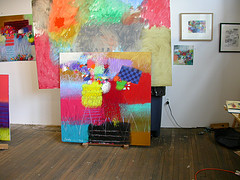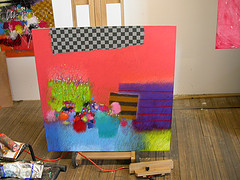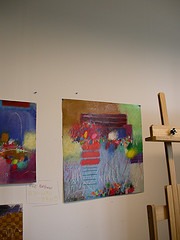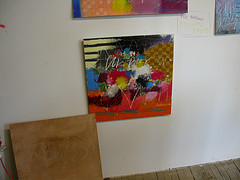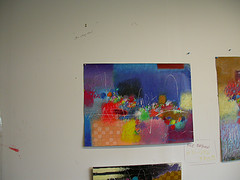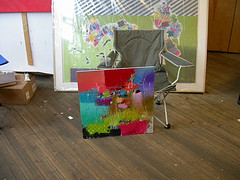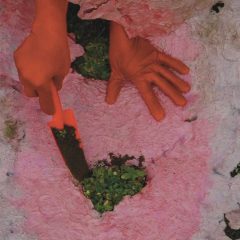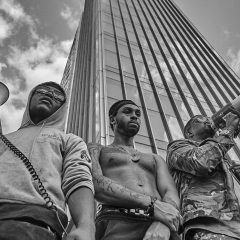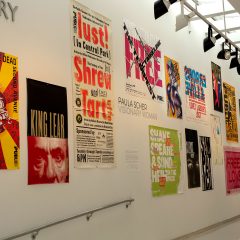Opening tonight at June Kelly Gallery in Soho, and running through July 28, are the ebullient, heart-felt paintings of Moe Brooker, one of Philadelphia’s best abstract artists.
I did a studio visit with Brooker a while back when he asked me to write the catalog essay for the show. It’s no secret that I’ve been a fan of Brooker’s art for many years. I’ve written about him for the Weekly and for artblog. And I think this new body of work — somehow simpler, bolder and more risk-taking — is just great. (click the images to see them big)
I’m going to put the catalog essay here on the blog. Hope you get to see the show in the flesh.
Concerning the Spiritual in Moe Brooker’s Art
“Color is the key. The eye is the hammer. The soul is the piano with its many chords. The artist is the hand that, by touching this or that key, sets the soul vibrating automatically.”-Wassily Kandinsky
When I met Moe Brooker at his studio last month he had dashed over from Moore College of Art and Design where he was reviewing student portfolios at the end of the semester. The artist, a Professor and Chair of the Basics Department at Moore, took a break from the reviews but would return there again after our visit.
As I thought of him racing back to his students after our conversation I realized that, just as in his paintings, Brooker’s life is a journey between events big and small, ordered by his energy and spirit. Brooker’s multi-tasking afternoon mirrored his event-filled paintings.
Brooker’s paintings are maps that take you on a journey through an imagined universe filled with microscopic moments and large delights. Think of a painting like “Ancient Futures” as a mythic meander similar to Leopold Bloom’s day journeying around Dublin in James Joyce’s “Ulysses.” Joyce’s Bloom is Everyman, and his small moments add up to the archetypical human story, the adventure that begins at birth, plows through love, fear, hope, desire, conflict and inspiration, and ends in death and infinity. Brooker’s world, too, with its elastic time and moments that overlap and collide and cadences that swing from pacific to riotous, is a statement of the human journey.
Brooker is a positivist and his works reflect the optimism of his spirit. That outlook comes from his deep connection to the spiritual. His term for this state of being is “unspeakable joy,” a phrase his grandmother used. The joy is an embrace of life—of God, the universe and humanity. And for Brooker there’s no better way to express the joy than in painting. The letters TTGG (To The Glory of God) appear at the bottom of Brooker’s paintings, a statement of his spiritual connection.
These paintings grow from the artist’s intent as well as from his intuition. They are made by a series of considered decisions fueled by issues of color, line and composition. While they are not impulsive works, they have moments of spontaneous combustion in which mind and hand work together subconsciously to spark a passage of perfect grace that’s like a painted prayer. Works like “The Way Back Before” or “Whole Fragment” arrived at their finish point after time spent looking, thinking, battling and break-through. As with many things, the greater the battle the bigger the break-through. Sometimes the artist looks for hours at a painting he’s working on and doesn’t make a mark. But he’s processing the painting all that time, making notes and schematics that will be mulled over, distilled into ideas and either incorporated or changed.
The artist names the Russian abstract painter Wassily Kandinsky when talking about how he became an abstract painter. Kandinsky’s book “Concerning the Spiritual in Art,” (1912) has been a big influence. And indeed, looking at Brooker and looking at Kandinsky, one sees an allegiance in the artists’ spirits. Kandinsky’s works are ebullient; full of bold color, energetic line and musical rhythms. So too are Brooker’s. Kandinsky was mapping the inner life in his works and so is Brooker. Kandinsky believed both in composing (ordering) a painting and in improvising (working intuitively). Brooker too uses both strategies.
One thinks of music when one looks at Brooker’s paintings. His lines and dots are staff lines and musical notes, and the procession of shapes evokes a symphony. Brooker’s connection to music is familial and communitarian. He sings in the choir at First African Baptist Church of Philadelphia and he sings with the Royal Priesthood, a group that sings gospel music, sometimes with a jazz inflection. He was the seventh son in a musical household where everyone played instruments and sang. Whether consciously or not, the artist’s paintings have song-like structures with passages that are pure call and response, verse and chorus.
Like many painters, Brooker revels in the sensual properties of oil and encaustic. He loves making the layers, using the pigment, mixing the hues that create deep or shallow space, and firing up the heat gun which transforms the waxy components into something lush, creamy and delicious. And his surfaces with their visible brush strokes and textures assert the artist’s hand and touch. In our time, so influenced by photography and digital production that we value its smooth, non-blemished surfaces above the craggy surface of a painted painting, the maker’s touch is the last bastion of the human hand in art. That loving touch is a hallmark of Brooker’s works.
These compositions are not anchored in space. The artist is not interested in horizon or real space. What he’s interested in is inner space, something cosmic and eternal and imagined. The works, in fact, feel like snapshots of the cosmos. The pure un-tethered and free-floating space is euphoric. Yet Brooker inserts a hint of danger with passages of intense darkness — purple, black, and blue to suggest a void, a bruise, a confusion, an unhappiness. For life is multi-dimensional and so is beauty. And dangerous beauties like mountains, the sea and the desert are all the more beautiful for being at times deadly.
Brooker told me that once he was a figure painter. Right out of the Pennsylvania Academy of the Fine Arts he would take his sketchbook and go to the storefront churches, sit in the back and sketch the congregation and take notes. Later he would hire models to pose and fine tune the compositions. But as he began working and thinking about color and space and line, and as he observed the urban environment so full of energetic grafitti markings, he was drawn to the idea of inventing his own space and color and expressing the world through his inner eye. His transition to making abstract art took around seven years.
Vestiges of that figurative painter still exist. They show up in the checkerboard patterns, for example, that appear in “There is always when” and “Kinda, Sorta.” Everyone’s got a checkerboard in their history, whether it’s a kitchen floor or a game board. To Brooker the checkerboard is Vermeer. Vermeer is the painter of light and pattern. Those are the dual structures that lead you through the Dutch master’s paintings. Like Vermeer, Brooker guides you through his works using light and pattern.
When I first encountered Brooker’s paintings, I wrote that they were “a scrumptious joy ride in the clouds.” The joyful ride is due to Brooker’s spirit of positivism and his sense of connectedness — to the cosmos, to a higher power and to humankind. At a time when much art is made with shallow intent and mirrors a fashion- and youth-obsessed pop culture, Brooker’s art is a drink from a deep well, and that is a generous gift.


